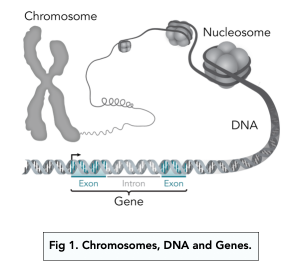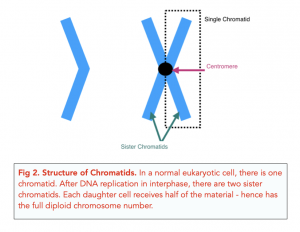Cell Division: Chromosomes (A-level Biology)
Cell Division: Chromosomes
Recap
- A chromosome consists of lots of DNA molecules.
- A DNA molecule has lots of genes.
- A gene has lots of base pairs.

Structure of Chromosomes
In order to fully and properly understand cell division, we first need to spend some time learning the structure of chromosomes.
- Chromosomes are large structures of DNA and proteins. DNA in cells is wrapped around proteins called histones. This results in a structure called chromatin. Chromatin is then coiled into structures known as chromosomes.
- Humans have 23 different chromosomes which exist in pairs. Humans are diploid organisms, meaning that we have two sets of each chromosome, making a grand total of 46 chromosomes in a single cell nucleus. Organisms with only one chromosome of each type are called haploid organisms. Organisms with three copies of each chromosome are called triploid, and those with four copies of each chromosome are called tetraploid.
- Each copy of a particular chromosome is called a chromatid. Each chromosome is made up of two copies – each one is called a chromatid. A chromatid has two arms which are held together by a specialised structure called a centromere. In most eukaryotic cells, two chromatids, called sister chromatids (which are both nearly identical copies of the same type of chromosome) are joined together at the centromere.
- During the S phase of the cell cycle, the cell replicates the DNA. DNA replication results in two copies of each chromosome. Since we normally have 46, after S phase, the cell will have 92 chromosomes, making it tetraploid. The new copies of chromosomes are called homologous chromosomes. The chromosomes will be evenly split during mitosis, with each daughter cell having 46 chromosomes.
- Telomeres protect the chromosomes during cell division. Telomeres are disposable sequences of repeated nucleotides at each end of a chromosome. With each successive chromosome replication, the chromosome will become shorter and shorter. The presence of telomeres mean that it will be the telomeres that get shortened during each replication and the genes in the chromosomes remain protected.

Chromosomes are structures in a cell that contain genetic material, also known as DNA. During cell division, chromosomes play a crucial role in ensuring that the genetic information is properly distributed to daughter cells.
Human cells contain 46 chromosomes, which are organized into 23 pairs. Each chromosome in a pair contains the same genetic information, except for the X and Y chromosomes, which determine a person’s sex.
Chromosome replication is the process by which cells make copies of their chromosomes before cell division. This process starts at specific points on the chromosome called origins of replication, and it results in the formation of two identical copies of the chromosome.
Chromosomes play a critical role in cell division by ensuring that each daughter cell receives the correct amount of genetic information. During mitosis, chromosomes are precisely aligned and separated, and during meiosis, chromosomes undergo cross-over and segregation to produce genetically diverse daughter cells.
Chromosomes and genes are closely related. Chromosomes contain the genetic information necessary for the development and function of an organism, and genes are specific segments of DNA that encode specific traits or functions.
Homologous chromosomes are pairs of chromosomes that contain the same genetic information, and they are present in diploid cells. Sister chromatids are identical copies of a single chromosome that are produced during replication, and they are present in both diploid and haploid cells.
The study of chromosomes and cell division is important in A-Level Biology because it provides an understanding of the underlying mechanisms that govern the inheritance of genetic information and the maintenance of chromosome stability. This knowledge is essential for understanding many biological processes, such as genetic disorders and cancer.
Common techniques used to study chromosomes and cell division include microscopy, such as light microscopy and electron microscopy, and molecular biology techniques, such as fluorescence in situ hybridization (FISH) and PCR. These techniques allow scientists to visualize and analyze chromosomes and their behavior during cell division.





Still got a question? Leave a comment
Leave a comment